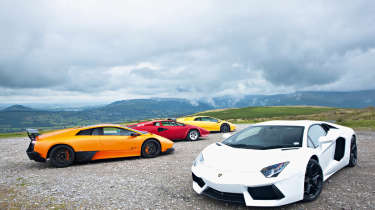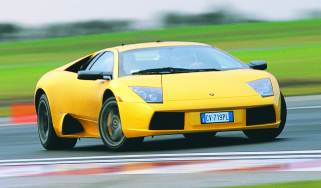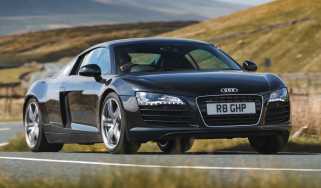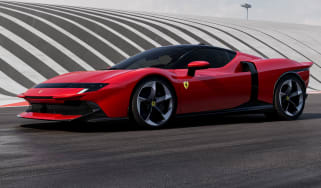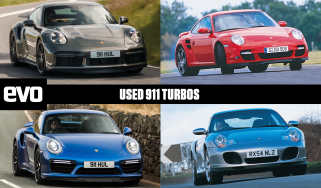Lamborghini Aventador meets Countach, Diablo, Murcielago
Lamborghini's all new V12 supercar, the Aventador, tackles its illustrious prececessors, the Countach QV, Diablo 6.0 VT and Murcielago SV
They look like nothing else, they sound like nothing else; they ensnare us with their ludicrous coachwork and outrageous proportions, but there is a paradox that is both central to and responsible for the greatness of many of Lamborghini’s road cars. It is this: despite the strutting-peacock styling and shameless exuberance of their silhouettes, these cars are actually best defined by the way they drive.
It is a fact that the foundations of Automobili Lamborghini were based on Ferruccio Lamborghini’s dissatisfaction with the performance and refinement of his Ferrari road cars, not with the way they looked. The story of his falling-out with Enzo Ferrari is well-known, but in the context of this test – one that sets out to discover the greatest Lamborghini road car – it’s important to remember that for a brand immortalised for a generation by vast aerofoils and pornographic Pirellis, the company was conceived through mechanical conviction, and not otherwise.
There endeth the lesson on the importance of recognising the driver-currency of the greatest Lambos – or at least it certainly ends when you are presented with these four cars on a Welsh hillside. There are no greater extroverts belonging to the genus Supercar than these wonderful creations.
How did we arrive at these four? Simple: we chose the ones we knew we could arrange for the photo shoot – hence the lack of a Miura. That’s a joke, by the way. The gorgeous Miura doesn’t make the grade on driving grounds. As anyone who has squeezed themselves inside will confirm, the reality is somewhat removed from the dream: it’s a pig. Prettier than a Countach, but this is evo and we are about driving and beholding, not just beholding.
There are Countaches and there are Countaches, and the QV is the one to have. This has been made clear to me in a lengthy email by a certain H Metcalfe, Editorial OverGod (or whatever he calls himself these days) of this magazine. The car you see here is his own, and sifting through the anecdotal and factual evidence in his extensive communication, he does seem to have a point.
The Countach might best be described as a point of friction between the opposing forces of aesthetics and vehicle dynamics. It was conceived as a styling exercise, then adapted for use on the public highway – but its genesis was hijacked by people with an obsession for high performance and, worse still, motorsport. Its tubular steel chassis was delicate but light and strong, as was the alloy body. The needless space-efficiency of the Miura’s transverse motor was ditched for a longitudinal V12 and from each corner hung a pair of wishbones. If ever you have the chance to see the bare Countach chassis at the factory museum, grab it: it’s a work of singular beauty and genius.
That first Countach, the LP400, shares its basic structure, styling and mechanical layout with this red beastie, but not much else. For starters, the Quattrovalvole is a good deal taller than those early cars, losing some of their flying-wedge appeal, but allowing grown adults to sit upright in the cabin. Harry is clearly basking in that early phase of ownership with his QV – the one that entails vast amounts of knowledge accumulation…
According to H, the quattrovalvole engine was developed after Lamborghini learnt Ferrari was due to launch an all-new model (which would turn out to be the Testarossa) and were worried their current V12 would be left behind in the power race. The new QV engine was ‘stroked’ for extra capacity and produced much more power than expected. Valentino Balboni (legendary Lambo test driver) reckons 470bhp was regularly seen on the dyno and 500bhp was achievable with a blueprinted engine. And yet Lambo quoted 455 at launch – to keep something up their sleeve in case the new Ferrari had more. When the Testarossa was launched with ‘only’ 390bhp, Lambo couldn’t believe the output was so low and never bothered to change the official figure. There was simply no reason to.
I never drove Countaches in period – because 12-year olds weren’t allowed to. But I did drive Diablos. I was transfixed by them because, unlike with Ferraris and Porsches, the magazine tests I’d read as a boy somehow didn’t prepare me in any way for the actual experience: the intimidation of those vast hips, the noise, the sheer difficulty. So much of a Diablo SV was so rubbish, but the bits that counted in terms of the driving experience were perfectly judged. This is a theme I want to explore over the next few pages, because it sits at the epicentre of what makes a great Lamborghini.
For me there were two stand-out Diablos: the crazy GT with its carbon-everything and exhaust noise from the darker reached of Hades, and the 6.0 VT. The latter may lack some of the GT’s shock-factor, but it is unarguably the better car. It was also, of course, the first car sold under Audi ownership.
Alistair McKillop bought his yellow 6-litre quite recently on the back of a sustained Ferrari love-affair and, allowing actions to outweigh words, says he hasn’t driven his 430 or 550 since taking delivery of the Lambo. ‘I just love it,’ he beams.
Love is something we all share for cars that straddle generations and carry with them great stories, and the 6.0 is definitely one of those. Audi’s purchase of Lamborghini had most of us grimacing at the thought of the company imposing its then staple dynamic cancer on Sant’Agata’s finest, like those god-awful black things from Harry Potter that suck the life out of you. In would come dreadful brake pedal feel, the body-control of an incontinent octogenarian and maybe, just maybe, some passable switchgear. We couldn’t have been more wrong.
The 6-litre Audighini was dynamically polished – better even than the ‘pure’ Italian cars. Its engine was treated to variable valve timing and completely new calibration that made it a puppy-dog at low revs but allowed it to remain a salivating psychopath at the top end. I thought it was captivating back in 2001: seeing one again reawakens lustful urges.
Next we leap to the end of the same decade: 2009. With the Diablo’s replacement, the Murciélago, now nearing retirement, Lamborghini decided to dust off the Super Veloce title and created the LP670-4 SV. It was, by some margin, the greatest of the Murciélago family and its significance radiates with the same aura as its older siblings. Power from the 6.5-litre V12 was 661bhp, up from the original 6.2- litre Murci’s 572bhp. Weight had been trimmed here and there, but this was still a fair lump of metal because it was to be the last of the old-school Lambo V12s: a steel spaceframe wrapped in lightweight panels and propelled by a V12 that could trace its lineage right back to the LP400. To hear the demented shriek of an LP670 above 7000rpm and be told it is directly derived from something nearly 40 years old is to be left in disbelief.
The hinge to this gathering is, of course, the arrival of the most significant development in the history of the V12 Lamborghini since messrs Bizzarini, Stanzani and Wallace embarked on the Countach project – the Aventador. The singular nature of its specification must surely have old Ferruccio grinning from his cloud.
Not only has Lamborghini blossomed under Audi, but it has somehow managed to become even more unhinged – the Germans seem to have treated their Italian patient like a smack addict, and just given it more heroin. The 670 SV proved the point – it was, and is, a truly extreme machine. At least as potty as anything attempted in the previous 40 years – with the exception of the LM002. But the Aventador attempts to take the game a stage further. Gone is the antiquated steel space-frame, replaced by a full carbon tub and pushrod suspension. An all-new 690bhp 6.5-litre V12 motor runs through a compact, lightweight, single-clutch gearbox bringing fast but aggressive gear-changes. A few years ago, this thing would have been eligible for Le Mans, and all with styling to make a McLaren MP4-12C weep into its Farah trousers.
I’m trying to think of something that makes you feel better about yourself than a truck unloading a white Aventador onto your driveway – a post-coital compliment perhaps; maybe Jackie Ickx expressing his admiration for your line through the Wipperman? Nah, the white Lambo is double Prozac with a Viagra chaser. I curtain-twitch most of the evening, then leave for the moors earlier than is strictly necessary.
The intimidation is still there – and thank God for that. The day that you climb into a V12 Lambo and drive it without fear of ripping something expensive from its body or, perish the thought, have any idea what is occurring behind your line of sight, is the day the world ends. The Aventador feels less ‘hippy’ than its predecessor, even though it is actually 1mm wider. Must be the less severe taper from front body width to the rear. Even so, you take extra care – and hold your breath – the first time you pass oncoming traffic the way you never would in a Ferrari 458.
Within a few miles the Aventador’s behaviour is provoking pertinent questions – ones that have never previously occurred to me in a big Lambo, because I’ve never driven one that is quite so technically, well, superb over broken road surfaces. It’s a recurring theme this, in the year of our Lord and supercar 2011 – the question of some element of rubbishness presenting itself as ‘character’ in a car of this type. Whenever you read the word ‘visceral’ in the context of a car magazine, perhaps you should substitute it with ‘crap NVH’ or ‘crippling driving position’? There is no such rubbishness here, just a genuinely gratifying feeling of immense, unshakeable torsional strength that facilitates the use of softer spring-rates. This car has suspension in a way the last 670 SV I drove had concrete dampers: it’s much more absorbent than a GT3 RS 4.0 – much more.
The engine takes time to unravel because its breadth of thrust is enormous – it pulls from 2000rpm to 8500rpm – but also because it has perhaps the most linear delivery of any V12. Again, notions of character contaminate your first impressions because there’s none of the angry chunter and brimstone of the old V12. It doesn’t hesitate at low revs or take a second breath during some variable-valve injection of energy. It just keeps going. And going.
The throttle travel is long and the springing firm, forcing you to push your near-horizontal leg further into the recesses of the footwell. But in the Aventador you also have to use that great Ferris wheel of a rev-counter because the thrust is so overwhelming that you naturally back off in the high-seven-thousands, at which point this newest bull has plenty more fear to unload. The steering requires less physical effort than the SV’s and the driving position makes the wheel feel less like it’s protruding several feet from the dashboard, but the carbon tub also forces your legs quite far to the left – a deliberate nod to those supercar compromises of old?
For road use, the chassis is mesmerising: it rides bumps, remains level and doesn’t understeer. Nor, for that matter, does it oversteer. Snapper Matt Howell asks for a little squiggle exiting a hairpin, and the car duly accepts all 690bhp without a whiff of corrective lock being needed. Only under extreme duress does it relinquish grip.
Stepping from the new kid into the Murciélago SV is like leaving Babbington House and heading for a week in Guantanamo Bay: if asked the age-gap between the two, you’d say, perhaps, 15 years. Certainly not the two years that separate them.
Everything that relaxes you in the new car – the ergonomics and the yielding seat cushions – has the opposite effect in the SV. It is unashamedly from another generation, a car so extreme that it feels closer in spirit to the Countach than the 6-litre Diablo.
People often wonder what the definitive supercar driving experience is, and I think the 670-4 SV might just offer the answer to that question. In a supercar we don’t necessarily look for technical achievements, leaning instead towards emotional embellishment – and here the SV has no rival in this test; perhaps in any test. It’s a jabbering ball of neurosis, a frothing race-horse, a great lump of friction that hurls itself at the horizon leaving you to savour the by-products of its vast appetite for fuel: noise and action (for the driver).
The transmission is slower than the Aventador’s, but actually more pleasant to use on the road, and none the worse for lacking the former’s ‘Corsa’ mode, which was surely created to support the chiropractic industry.
Deconstruct the car’s behaviour in the context of its replacement and the SV has few answers in terms of composure and resulting cross-country speed, but does that really matter in the context of a great Lamborghini? I’m not sure it does. I climbed out of the SV as if the seat had injected me with amphetamine-laced Red Bull. It’s just so naughty, so clearly too big for any public road, so god-damn-it-understeery-then-SNAP!-jeeeeeeeeepers-oversteery it demands full concentration and rewards accordingly. It is also savagely fast – to this backside the equal of the new Aventador. The old V12 may not have the available rev-range, but its character is more strident and the resulting surges and crescendos of its less perfect calibration make the new V12 seem slightly antiseptic. I have a clip of it accelerating through 1st, 2nd and 3rd on my computer; I’ve listened to it dozens of times – the noise above 6500rpm is unlike any other street car, a shrill, vaguely hollow shriek that penetrates the surrounding air more perniciously than any other car here.
Its voice isn’t the purest expression of the famous old V12 in this test though. That honour belongs to the 6-litre Diablo and its Larini exhaust – not a combination for the serial introvert. And how the benefit of hindsight helps those of us who drove these cars when new understand their significance now: the 6-litre Diablo is a Murciélago in drag. The steering feels identical to an early Murci’s, the power delivery has that familiar thrum and oscillation through the chassis (something, curiously, the Aventador does at an 85mph cruise too) and even though the Diablo’s dash architecture is way more bizarre, the feeling of the wheel reaching way into the cabin space makes you think, ‘This was just an early test-bed for the Murciélago.’
This example doesn’t discredit those fond memories of 2001, despite showing over 35,000 miles. The manual gearbox is a peach, the clutch a bastard. You feel like the captain of a 737 – right at the pointy end of a vast machine (the wide wing mirrors really only give the driver a view of those voluminous thigh-bones). But despite initial intimidation, a few minutes later the car is drifting wide on the exit of turns and you’re in awe of its inherent balance. It’s yet another reminder how misleading Lamborghini’s Athena poster image is: there is no doubt that the 6-litre Diablo is a superior driving device to its Ferrari contemporary, the 575 Maranello – even with the Fiorano handling pack fitted. And so much of that comes from the engine’s appetite to work and rev. Whereas the 550/575’s V12 became breathless at the very top end, the Diablo 6-litre keeps pulling.
And then there’s the 4wd system: one that gives a driver confidence in the wet, and yet still leaves the car feeling rear-driven under normal conditions. The 6-litre defines the roles of intimidation and eye-popping speed under any conditions. The leap of faith required to turn one into the other is one of the most satisfying motoring experiences, like finally taking a corner of a race-track flat-out when previously you thought it just wasn’t possible. You can grab a 6-litre by the neck, and drive it like you rented it. Or borrowed it. Sorry Alistair.
And so to the Countach. Talk of 10sec dead from 0-100mph might be a little far-fetched, even for this healthy Quattrovalvole. What isn’t in doubt is how embarrassingly slow a Testarossa must have felt after one of these, nor how outrageous the Countach still feels despite the world now being awash with modern supercars. This is the original drivers’ supercar, and quite possibly the best.
Its racing car origins shine through in the way it drives, with fully uni-balled suspension and a kerbweight almost 200kg under the 6-litre’s. As someone who has never driven a Countach before, besides realising a boyhood dream, it left me trying to name a car whose driving position and controls (all of them heavy as hell) were less indicative of the way it covers ground. Once it’s up and running, the Countach is a blast, a cardiovascular gym session drenched in carburettor gurgle and rasping V12 overrun. Heavy, but useable. If you had told me last month that I would enjoy a Countach oversteering and, apart from nearly dislocating my shoulder in the process, find it to be quite controllable at a slip angle, I would have called you a liar. What a journey of learning this is.
The Countach also reminds us what a car of vast mechanical power used to feel like before powered controls and electronic assistance: the reason for not provoking the car into oversteer more often is the weight of the steering, not the expected visciousness of a mid-mounted V12. It’s always heavy, the rack, but it’s like a glass-bottomed boat compared with the others’ painted plastic hulls. It chatters, constantly.
The clutch travel is so long my tiny legs struggle to fully disengage it, and the throttle pedal doesn’t so much release the horsepower as tell a story every time it moves: you feel the hinged pedal creak a little and pull that ancient cable a few inches forward, coaxing life from the bevy of carburettors. It’s so unashamedly mechanical: a warm glow if you get it right, your own page on WreckedExotics.com should you be less successful.
There are four great cars here; four great Lamborghinis. In a way it’s unfair to judge the Aventador directly against its predecessors because in being so accomplished it cannot quite satisfy the cravings of those who, for want of a better word, want that visceral experience. But there can be little doubt that the Aventador is the best V12 Lamborghini ever made.
The other three all suffer from unfortunate cultural associations – the poster generation for the older two, the R&B video for the youngsters – and this means people still see them as plumage rather than substance. The truth is they are truly great drivers’ cars. The 6-litre Diablo VT is the ultimate incarnation of Italian wackiness and Audi-Technik; the LP670-SV nails the generic role of the flamboyant Lambo V12 supercar even more convincingly than its successor.
I loved driving both, but where they were pleasant surprises, the Countach was a shock. It has no right to be such a great driving machine, and much as I hate the thought of bolstering the residual values of Harry’s latest toy, the world needs to wake up to the Countach as a driving machine. This is the alarm call.
